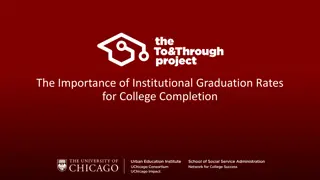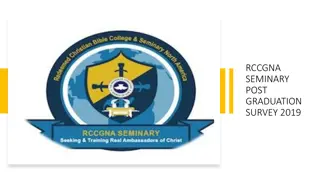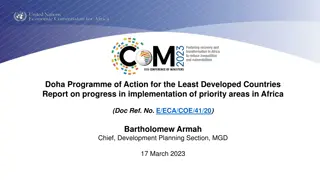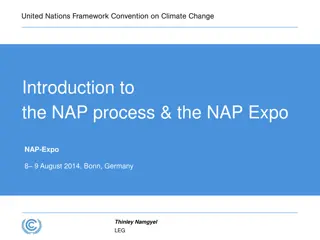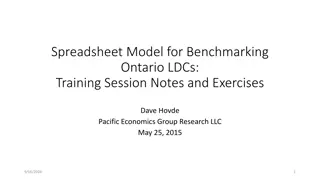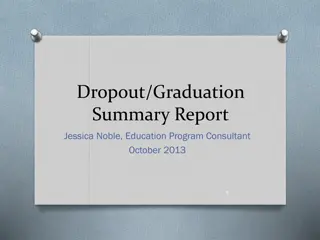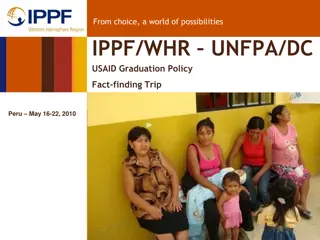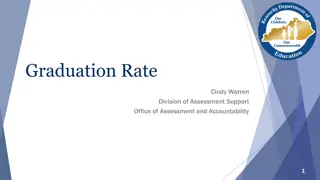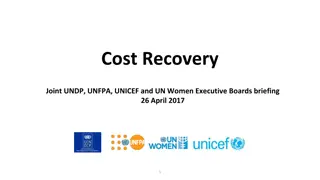Challenges and Opportunities of LDCs Graduation: UNDP's Role
Overview of the challenges and opportunities faced by Least Developed Countries (LDCs) in the graduation process, highlighting the criteria, countries already graduated, and those scheduled for graduation. The presentation discusses the role of UNDP as a strategic partner in supporting LDCs through the transition process, emphasizing the sticky nature of graduation due to weak capacity in managing economic vulnerability and fears of losing privileges.
Download Presentation

Please find below an Image/Link to download the presentation.
The content on the website is provided AS IS for your information and personal use only. It may not be sold, licensed, or shared on other websites without obtaining consent from the author. Download presentation by click this link. If you encounter any issues during the download, it is possible that the publisher has removed the file from their server.
E N D
Presentation Transcript
C Challenges and opportunities of LDCs Graduation: hallenges and opportunities of LDCs Graduation: UNDP as a Strategic Partner in the Graduation Process UNDP as a Strategic Partner in the Graduation Process Ayodele Odusola, PhD Chief Economist and Head Strategy and Analysis Team UNDP Regional Bureau for Africa, New York
Overview of the presentation Overview of the presentation Highlight of LDCs Graduation since 1971 Angola: A sleeping Giant in Africa Transitory and structural opportunities to graduation Challenges and risks facing LDCs graduation process UNDP as a strategic partner in the graduation process 2
Overview of LDCs Graduation since 1971 (1/3) Overview of LDCs Graduation since 1971 (1/3) Current graduation criteria Countries already graduated Botswana (19 Dec 1994) economic and precautionary conditions GNIpc Cape Verde (20 Dec 2007) --- GNI per capita + HAI HAI % of under malnourished, U-5MR Gross Sec Enrolment Ratio, and Adult Literacy Rate Maldives (1 Jan 2011) --- GNI per capita + HAI Samoa (Jan 2014) - ---- GNI per capita + HAI EVI Pop, Remoteness, export concentration, % of agric., % of pop in elevated costal zones, victims of natural disaster, instability of agric. production, instability of exports 3
Overview of LDCs Graduation since 1971 (2/3) Overview of LDCs Graduation since 1971 (2/3) Potentials for graduation Countries scheduled for graduation Equatorial Guinea Tuvalu Met criteria but not yet recommended 2017 Kiribati Vanuatu 2020 Bhutan, Nepal, STP, Solomon Islands Timor Leste Met criteria for the first time; could be recommended by 2020 Angola 2021 4
Overview of LDCs Graduation since 1971: Overview of LDCs Graduation since 1971: Why is graduation so sticky? (3/3) is graduation so sticky? (3/3) Why Weak capacity to manage economic vulnerability and social transformation No country graduated under economic vulnerability criterion Maldives, Cabo Verde, Samoa, Equatorial Guinea and recently, Vanuatu, arising from the 2014 tragic cyclone Fear of losing privileges 5
Angola: A Sleeping Giant in Africa Angola: A Sleeping Giant in Africa 18000 Graduation message focus more on: Human asset development Economic diversification 16000 Seychelles 14000 Per capita Income 2015 ($) 12000 Equatorial Guinea 10000 Mauritius Gabon 8000 Botswana 6000 South Africa Namibia Libya Algeria Angola 4000 Tunisia Egypt, Arab Rep. Swaziland Cabo Verde Morocco Nigeria Sudan 2000 Congo, Rep. Djibouti Lesotho Zambia Sao Tome and Principe Cameroon Cote d'Ivoire Ghana Senegal Sierra Leone South Sudan Uganda Zimbabwe Kenya Mauritania Tanzania Comoros Guinea-Bissau Benin Burkina Faso Burundi Central African Republic Congo, Dem. Rep. Gambia, The Guinea Liberia Madagascar Malawi Mozambique Niger Somalia Togo Chad Mali Rwanda Ethiopia 0 0 1E+11 2E+11 3E+11 4E+11 5E+11 6E+11 GDP Size 2015 ($) 6
Transitory opportunities Preferential market access Special & differentiated treatment on WTO obligations Trade related measures Measures on capacity building on trade ODA International support measures General support measures Contribution to general budget (0.01% and 10%) Other support measures Education and research facilities 7
Structural and non-structural opportunities Structural Opportunities Non-structural Opportunities Domestic resource mobilization Remittances ICT Natural resource endowment Agricultural productivity Youthful population Regional integration Emerging donors 8
Structural and emerging risks to LDCs Structural and emerging risks to LDCs Graduation Graduation Structural risks Emerging risks Managing shocks and vulnerability High poverty and inequality Climate change debacle Terrorism and Violent Extremism SMEs limited access to finance (high lending rate, limited access to non-debt financing, asymmetric fiscal support) Emergence of unpredictable diseases Ebola & Bird flu Low human capital Over dependency on primary commodity Rising fragility Youth budge Global economic crisis Weak implementation of international support measures Weak economic governance Rising cost of remittances 9
Emerging lessons and messages Emerging lessons and messages The evolution of the criteria does not measure structural changes in the socio-economic situation of countries given the objective of IPOA. Achieving IPOA s goal in Africa necessitates enhancing agricultural productivity and diversifying economies away from primary commodities production and exports Countries are not taking full advantages of transitory measures LDCs must invest in maximizing opportunities and in minimizing risks for smooth graduation 10
UNDP as a Strategic Partner on LDCs Graduation Facilitate preparation of Smooth Graduation Strategy (SGS) Build Support preparation of national progress report on SGS partnership around graduation strategy implementation Mainstream SGS into national strategies Alignment of programmatic interventions 11
THANK YOU 12



